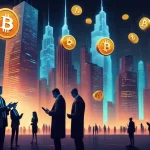Philippines Blockchain Boom: Bold Innovation or Risky Overreach?

Philippines Bets Big on Blockchain: A Rising Star or a Risky Gamble?
The Philippines is making waves in the blockchain arena, positioning itself as a potential powerhouse in Southeast Asia with aggressive government support and regulatory frameworks that aim to foster innovation. But with significant hurdles like public ignorance and creaky infrastructure, is this digital dream built on solid ground or wishful thinking? A deep dive into the Philippine Blockchain Report 2025 by the Blockchain Council of the Philippines (BCP) reveals a nation hungry to lead the decentralized tech charge while grappling with very real challenges.
- Government Drive: Bold policies from the Bangko Sentral ng Pilipinas (BSP) and Securities and Exchange Commission (SEC) are fueling blockchain growth.
- Innovative Projects: Peso-backed stablecoins and central bank digital currencies (CBDCs) are being tested to reshape finance.
- Tough Roadblocks: Awareness gaps and digital divides threaten to derail mainstream adoption.
- Global Ambition: Special economic zones aim to make the Philippines a competitive fintech hub.
The Government’s Blockchain Blueprint: Vision Meets Action
Let’s get straight to the point: the Philippines isn’t messing around when it comes to blockchain. Since 2017, the Bangko Sentral ng Pilipinas (BSP), the nation’s central bank, has recognized digital currencies as a legitimate payment method under Circular No. 944—a gutsy move when most governments were still side-eyeing Bitcoin as a passing fad. By 2021, Circular No. 1108 brought Virtual Asset Service Providers (VASPs) under scrutiny, enforcing anti-money laundering (AML) rules and IT security standards to keep the scammers at bay, as detailed in recent analyses of Philippine blockchain policies. But don’t mistake this for an open-door policy; a three-year moratorium on new non-bank VASP applications, running from September 2022 to September 2025, proves the BSP is playing hardball, prioritizing stability over unchecked growth.
The BSP isn’t just writing rules—they’re rolling up their sleeves. Local crypto exchange Coins.ph got the green light to pilot the Philippine Peso-backed stablecoin (PHPC) in a regulatory sandbox, which, for the uninitiated, is a controlled testing ground where companies can experiment with new financial products under relaxed oversight. A stablecoin, by the way, is a cryptocurrency tethered to a fiat currency like the peso to avoid the wild price swings of Bitcoin, making it a practical tool for payments or savings. Recent updates on the PHPC pilot progress highlight its potential. Then there’s the push for central bank digital currencies (CBDCs) with initiatives like Project CBDCPh, focusing on wholesale CBDC for interbank transactions, and Project Agila, which wrapped up testing in December 2024 with a roadmap slated for 2025. These aren’t mere buzzwords; they’re experiments that could redefine money flows in a country where over 50% of people are still unbanked.
The Securities and Exchange Commission (SEC) is also in the game, setting up the PhiliFinTech Innovation Office and SEC StratBox to sandbox crypto services—think of these as safe zones for startups to test bold ideas without tanking the economy. They’ve rolled out detailed rules for Crypto-Asset Service Providers (CASPs) and are even mulling over a crypto derivatives market, signaling a forward-thinking yet cautious approach. Meanwhile, special economic zones like the Cagayan Economic Zone Authority (CEZA), branded as the Crypto Valley of Asia fintech hub, are luring blockchain businesses with updated 2024 frameworks such as the Financial Technology Solutions and Offshore Virtual Currency Business Rules. A recent collaboration with LegalBison, as highlighted by lead legal counsel Eira-Federica Järvi, aims to align CEZA with global standards. Järvi nails the intent:
“These updates are designed to make CEZA more competitive, attracting responsible fintech innovation to the region.”
Not to be outdone, the Authority of the Freeport Area of Bataan (AFAB) offers Offshore Digital Asset Licences (ODAL) to draw in offshore fintech players. This isn’t just policy on paper—it’s a calculated bid to make the Philippines a magnet for blockchain investment.
Blockchain in Action: From Public Services to Grassroots Gains
Beyond regulations, government agencies are embedding blockchain into public services to boost transparency and efficiency. The Department of Information and Communications Technology (DICT) launched eGOVchain to streamline public processes, while the Department of Budget and Management (DBM) uses Project Marissa, powered by BayaniChain’s hybrid blockchain tech—a mix of public and private blockchain features—to secure budget documents. Curious what that means? It’s essentially a system that balances accessibility with tight security for sensitive data. The Bureau of the Treasury (BTr) grabbed headlines in 2023 by issuing tokenized treasury bonds with local exchange PDAX, turning traditional investments into digital assets on a blockchain. They’re also testing blockchain-based investment access via GCash’s “GBonds” feature, a popular mobile wallet. Even the Maritime Industry Authority (MARINA) jumped in with its Blockchain-Enabled System for Transactions (BEST) for maritime services. These moves scream one thing: the government sees blockchain as a fix for systemic inefficiencies, not just a shiny toy, aligning with broader blockchain initiatives in the Philippines.
Now let’s talk real impact. Overseas Filipino workers (OFWs) send home over $30 billion annually, accounting for nearly 10% of the nation’s GDP, but traditional remittance services like Western Union often gouge fees of 5-10%. Blockchain initiatives like Project i2i aim to slash that to near-zero, akin to sending money as easily as a text message. That’s a lifeline for the unbanked, who make up half the population, offering them financial access without the predatory middlemen. Then there’s the play-to-earn (P2E) gaming boom—think Axie Infinity, a blockchain game that exploded during the pandemic, turning rural Filipinos into crypto earners overnight. These aren’t just side hustles; they’re micro-economies sprouting where traditional jobs never reached.
Roadblocks and Risks: The Harsh Reality Check
Before we get too starry-eyed, let’s face the ugly truths laid out in the BCP report. A staggering 70% of Filipinos don’t even know what blockchain is, despite 74% trusting its security—thanks largely to familiar platforms like Coins.ph and PDAX. Yet, 85% have zero direct interaction with blockchain in daily life. Why? Digital infrastructure is a disaster—only about 60% of rural areas have reliable internet, leaving entire communities cut off from this so-called revolution. Add to that a funding drought for startups and a crypto Wild West full of snake-oil salesmen preying on the clueless, and you’ve got a recipe for stunted growth. Scams are rampant, exploiting the uninformed with fake ICOs and Ponzi schemes dressed up as “blockchain breakthroughs.” Without serious education efforts, adoption is just a pipe dream, a sentiment echoed in discussions around blockchain adoption challenges in the Philippines.
Let’s not ignore the digital divide’s deeper roots. Urban centers like Manila might have 4G and fintech apps galore, but rural provinces struggle with basic connectivity. Government projects like eGOVchain sound promising, but how do you digitize public services for folks who can’t even get online? And while the pandemic shifted perceptions—more Filipinos saw digital tools as secure and necessary—trust doesn’t equal understanding. The BCP notes a curious paradox: confidence in blockchain’s security is high, but actual usage is abysmal. This isn’t just a tech problem; it’s a cultural and economic chasm that no amount of shiny CBDC pilots can bridge overnight.
The Flip Side: Are We Moving Too Fast?
Here’s where we play devil’s advocate. The government’s zeal is impressive, but is it reckless? Some argue that heavy-handed moves like the VASP moratorium could choke the life out of innovation, scaring off startups before they even get started. Bitcoin maximalists, who live and breathe decentralization, might roll their eyes at CBDCs, calling them lipstick on a surveillance pig—centralized control masquerading as progress. Unlike Bitcoin’s permissionless network, where no government can track your every move, a CBDC could easily become a tool for mass monitoring if privacy isn’t baked into the design. Imagine every peso transaction logged, analyzed, and potentially weaponized by the state. That’s a far cry from the freedom crypto was meant to deliver, raising questions about how the Philippines is implementing CBDCs.
Even stablecoins like PHPC, while practical, tether users to fiat systems still influenced by central banks. For purists, Bitcoin remains the gold standard of financial sovereignty—untouchable by bureaucrats. Yet, there’s a counter-counterpoint: altchains like Ethereum and niche projects like tokenized bonds or P2E games fill gaps Bitcoin doesn’t touch. They’re not competing with BTC’s store-of-value status but complementing it by tackling real-world use cases like remittances or government inefficiencies. The Philippines’ blend of centralized and decentralized experiments might annoy the hardcore crowd, but it’s a pragmatic way to test what sticks in a messy, emerging economy.
Global Stage: Can the Philippines Compete?
Looking outward, the Philippines is angling to rival blockchain hubs like Dubai or Estonia. CEZA’s “Crypto Valley of Asia” and AFAB’s offshore licenses are bold plays to attract global fintech firms, especially with LegalBison’s recent push to sync frameworks with international norms as seen in recent developments at CEZA. Compare this to Singapore, where strict but clear regulations have lured billions in crypto investment, or Estonia, where e-governance on blockchain is already mainstream. The Philippines has a younger, tech-savvy population—over 80% smartphone usage—and a dire need for financial inclusion, giving it a unique edge. But without fixing rural internet access or ramping up education, it risks being a second-tier player, hyped on potential but short on delivery.
Regulatory evolution is on the horizon, with tighter compliance and clearer roles between BSP and SEC expected. More investment in infrastructure and public awareness campaigns could build trust, but it’s a race against time. Scammers won’t wait for the government to catch up, and neither will global competitors. If the Philippines can balance its blockchain gamble—nurturing innovation without inviting chaos—it might just carve out a spot as Asia’s decentralized darling. Fail to address the digital divide or scam epidemic, and it’s just another overhyped experiment.
Key Takeaways: Unpacking the Philippines’ Blockchain Surge
- What’s powering blockchain growth in the Philippines?
Progressive regulations since 2017 from the Bangko Sentral ng Pilipinas (BSP) and Securities and Exchange Commission (SEC), coupled with projects like the peso-backed stablecoin (PHPC) and CBDC pilots, are driving the nation toward a fintech leadership role in Southeast Asia. - How does blockchain benefit everyday Filipinos, especially the unbanked?
By slashing remittance fees for overseas Filipino workers (OFWs) from 5-10% to near-zero and enabling financial access through initiatives like Project i2i, blockchain offers a vital alternative, while play-to-earn gaming creates new income streams for rural communities. - What are the biggest obstacles to blockchain adoption?
A 70% public awareness gap, rural internet access at just 60%, and rampant crypto scams exploiting the uninformed are stalling trust and integration, despite regulatory strides. - Do centralized solutions like CBDCs clash with decentralization’s ethos?
Potentially—while CBDCs promise efficiency and inclusion, they could enable government surveillance if privacy isn’t prioritized, clashing with Bitcoin’s permissionless freedom that many in the crypto space hold sacred. - Can the Philippines emerge as a global blockchain contender?
With zones like CEZA’s “Crypto Valley of Asia” and frameworks aligning to global standards, the potential exists, but success hinges on bridging infrastructure gaps and educating the masses to rival hubs like Dubai or Estonia.
The Philippines stands at a crossroads in its blockchain journey. It’s betting hard on decentralized tech to solve entrenched problems—sky-high remittance costs, financial exclusion, bureaucratic inefficiencies—while wrestling with the gritty realities of adoption. For Bitcoin diehards, the centralized undertones of CBDCs and stablecoins might sting, but there’s no denying the practical value of altchain experiments and niche use cases in pushing this revolution forward. This isn’t just a local tale; it’s a test case for how emerging economies can leapfrog outdated systems. Will this gamble crown the Philippines a beacon of digital freedom, or will centralized control and systemic flaws steal the show? That’s the billion-peso question.



